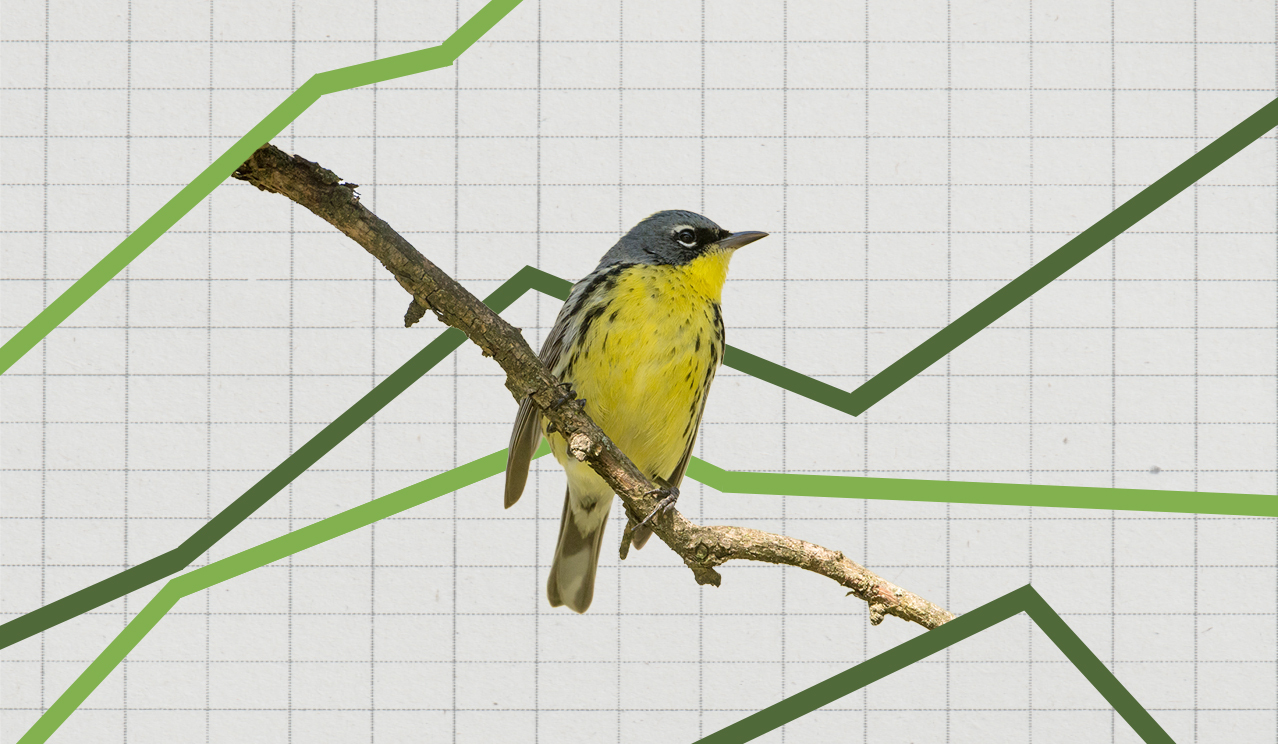
By the Numbers
3%
of species listed have ever recovered
300
the number of species that the U.S. Fish and Wildlife Service projected to recover by now
57
the number of species that have actually recovered
85%
of listed species have completed or partially completed less than a quarter of their recovery objectives
Introduction
When the Endangered Species Act passed 50 years ago, its goal was clear: to recover listed species to the point that they no longer need the act’s protections. Fifty years later, how much progress has been made to recover listed species? Using data from the U.S. Fish and Wildlife Service, this analysis compares the number of species that have recovered to the number the agency projected should have recovered by now. It also examines the agency’s overall progress at implementing recovery plans, producing an up-to-date assessment of the status of endangered species recovery.
We find that the Fish and Wildlife Service lags behind its own recovery projections for listed species. The agency has recovered just 57 domestic species, far fewer than the 300 species it projected to have recovered by now. Most species remain listed for years, if not decades, longer than anticipated.
In addition, the Fish and Wildlife Service struggles to meet the objectives outlined in its own recovery plans. For the vast majority of listed species, the agency has completed or partially completed less than a quarter of the actions prescribed in its recovery plans. Even recovered species have accomplished a surprisingly low percentage of recovery objectives, suggesting that recovery plans may not be capturing the actions most important for species recovery. These missed targets and slow progress toward recovery objectives may help explain the Endangered Species Act’s poor track record of species recovery over the past half-century.
Key Findings
- Only 3 percent of listed species have ever recovered. Of the 1,732 domestic species listed under the Endangered Species Act in the past 50 years, just 57 have been delisted due to recovery.
- Most of the species projected to recover by now have not. The Fish and Wildlife Service projected to recover 300 species by 2023, but only 13 of those species have recovered. The other 44 species that recovered did not have projected recovery dates.
- The Fish and Wildlife Service consistently struggles to meet its recovery objectives. According to the agency’s own assessment of its progress implementing recovery plans, 85 percent of species have completed or partially completed less than a quarter of their recovery actions.
- The percentage of recovery actions completed for recovered species is also surprisingly low, although more actions have been completed for recovered species than unrecovered species. This suggests that, in addition to the Fish and Wildlife Service making little progress on the recovery actions it has identified in recovery plans, those actions may not capture what is most important for effective species recovery.
Recovery Progress
Less Than Expected
Although nearly all of the species listed under the Endangered Species Act have thankfully avoided extinction, the law has fallen short of its ultimate goal to recover species. Just 3 percent of listed species—57 of 1,732 domestic species, or 71 of all listed 2,378 species—have ever recovered and been delisted. In addition, only 58 species have been downlisted from endangered (in danger of extinction) to threatened (likely to become endangered within the foreseeable future).1U.S. Fish and Wildlife Service, Environmental Conservation Online System, Reclassified Species. This low recovery rate has raised questions about the act’s ability to motivate the actions needed to recover species to the point that they no longer need the law’s protections.
Recovering species is an admittedly difficult task. It takes time and resources as well as collaboration with private landowners, states, and other conservation partners. And each species has different recovery needs, some of which can take years to complete under even the best circumstances. While the overall recovery rate suggests that much more work is needed to recover listed species, it does not take into account how long the Fish and Wildlife Service predicted recovery would take for each species. To evaluate whether a 3 percent recovery rate represents success or failure, we need to know how many species could or should have recovered by now.
Fortunately, the Fish and Wildlife Service has issued projected recovery dates for many species.2U.S. Fish and Wildlife Service, Recovery Reports to Congress. Using data from the agency’s biennial reports to Congress, we compare the projected number of recovered species to the actual number of recovered species as of the Endangered Species Act’s 50-year mark.3We use recovery projections listed for domestic species in the Fish and Wildlife Service’s biennial reports to Congress from 2006 to 2014. Prior to 2006 and after 2014, the agency’s reports to Congress do not include projections of recovery dates. Our data on recovered species is current through June 2023. See data appendix for more information on data collection, cleaning, and aggregation. We find that the agency projected it could recover 300 domestic species by 2023, compared to only 57 domestic species that did recover, meaning the agency projected at least 243 more species to recover than actually did.
Of the 57 species that recovered, the Fish and Wildlife Service projected only 13 of them to recover by now; the other 44 were species for which the agency did not predict a recovery date. This means that the “projected recovery rate,” the agency’s success rate at recovering species it projected should have recovered by now, is 4 percent (13 out of 300). This projected recovery rate is nearly the same as the overall recovery rate. The agency also projected recovery dates beyond 2023 for another 169 species, with at least 30 not predicted to recover until after 2060, including several not expected to recover until next century.
Many species remain listed for years, if not decades, longer than anticipated. There are 287 species that remain listed even though the agency projected them to have recovered by now. These unrecovered species are an average of 11 years past their projected recovery date, with some species overdue by more than 30 years. At the current rate of recovery (roughly 4 domestic species per year over the past decade), it would take the Fish and Wildlife Service another 70 years to recover the remaining 287 species it projected to recover by now.
Most Species Lack Progress Toward Recovery Plans
Not only does the Fish and Wildlife Service lag behind its own recovery projections, it also struggles to implement recovery plans. The Endangered Species Act directs the agency to develop recovery plans that specify actions that are needed to recover each listed species. Often described as “roadmaps” to recover listed species, the plans identify the needs of each species and define recovery actions to address those needs.
To its credit, the agency maintains a comprehensive database on its progress toward the recovery actions outlined in each species recovery plan. Recovery actions are categorized with priority levels that range from 1 to 3. These actions include substantive tasks such as addressing specific threats, relocating species, and protecting habitat, as well as more procedural tasks such as developing management plans, conducting surveys, monitoring populations, and disseminating public information.4The Fish and Wildlife Service defines priority 1 tasks as actions that must be taken to prevent extinction or to prevent the species from declining irreversibly in the foreseeable future. Priority 2 tasks are actions that must be taken to prevent a significant decline in species populations or habitat quality or some other significant negative impact short of extinction. Priority 3 refers to all other actions necessary to meet the recovery objective.
Analyzing this data, we find that the Fish and Wildlife Service has made little progress toward the recovery objectives outlined in recovery plans for the vast majority of listed species. According to the agency’s own assessment, it has completed or partially completed less than a quarter of recovery actions for 85 percent of listed species. Most recovery actions remain in various stages of incompleteness, including “not started” (24 percent), “ongoing current” (49 percent), “ongoing not current” (14 percent), “planned” (2 percent), and “unknown” (1 percent).5The Fish and Wildlife Service defines recovery action statuses as follows: “complete” means the action is completed and no further actions are necessary; “partially complete” means that the action has a definitive timeline and progress has been made but further work is needed to bring the action to completion; “ongoing current” means that an action needs to occur periodically or continuously; “ongoing not current” means that an action needs to occur periodically or continuously but is behind schedule; “planned” means that the action has been identified but has not been implemented; “not started” means that the action has not begun; and “unknown” means the status of planning or implementation is not known. By any reasonable measure, a substantial amount of recovery work is still needed for most listed species.
Recovering species takes time, so perhaps the agency has made more progress toward recovery objectives for the species that have been listed longest. This, however, does not appear to be the case. When we consider only species listed for several decades, recovery-plan progress remains meager. The agency has completed or partially completed less than a quarter of its recovery objectives for more than 90 percent of species listed for 30 or more years. Despite being listed for at least three decades, these species have completed or partially completed less than 10 percent of their recovery objectives, on average.
Perhaps the Fish and Wildlife Service is focusing on more substantive recovery actions at the expense of more procedural actions. Yet this also does not appear to be the case. When we examine recovery progress by priority category, we find little evidence that the agency is favoring priority 1 actions substantially more than priority 2 and 3 tasks. For all listed species, just 13 percent of priority 1 actions are complete or partially complete, compared to 11 percent of priority 2 actions and 7 percent of priority 3 actions. In fact, more priority 1 actions are listed as “not started” than are completed or partially completed.6If we restrict the sample to only include species listed for 30 years or more, there appears to be little or no difference in the status of the three priority categories. For those species, the Fish and Wildlife Service has completed or partially completed 18 percent of priority 1 actions, 16 percent of priority 2 actions, and 16 percent of priority 3 actions. Across all priority areas, most recovery actions are “ongoing current,” “not started,” or “ongoing not current.”
Little or no overall progress has been made toward recovery-plan objectives in the past several decades. At the 30th anniversary of the Endangered Species Act, the Fish and Wildlife Service reported that it had achieved a quarter or less of its recovery objectives for 76 percent of listed species and more than three-quarters of its objectives for only 2 percent of species.7Using similar metrics as this analysis, the agency previously estimated the extent to which it had met overall species recovery objectives. See, e.g., U.S. Fish and Wildlife Service, “Recovery Report to Congress Fiscal Years 2003-2004” (September 30, 2004). The agency stopped reporting this metric in 2006. Species that had been listed for more than a decade fared only slightly better, with 64 percent achieving a quarter or less of their recovery objectives.8The Fish and Wildlife Service did not report this data at the Endangered Species Act’s 40th anniversary. Given our finding that 85 percent of listed species today have completed or partially completed less than a quarter of their recovery actions, it appears the agency has fallen even further behind in implementing recovery plans over the past 20 years.
Recovery Plans May Not Capture What's Most Important for Recovery
Listed species face a variety of challenges that may make recovery difficult to achieve. Recovered species, on the other hand, have achieved sustainable population levels that enabled them to be delisted. So it is reasonable to expect that recovered species would have made more progress toward their recovery plan objectives than unrecovered species. But how much so?
Although we find that recovered species have indeed completed more of their recovery plan objectives than unrecovered species, recovered species have also made surprisingly little progress toward these objectives. On average, the Fish and Wildlife Service has completed or partially completed 28 percent of recovery objectives for recovered species, compared to 11 percent for unrecovered species. In other words, most species have recovered and been delisted despite a majority of their recovery plan objectives remaining incomplete.
This suggests that, in addition to the Fish and Wildlife Service making little progress on the actions it has identified in recovery plans, those actions may not capture what is most important for effective species recovery. It may also imply that species are often recovering for reasons unrelated to the agency’s recovery efforts.
Not on Time, Not on Target
These findings have numerous implications for the future of endangered species policy. Exploring them in detail is beyond the scope of this analysis, but we conclude with several initial observations:
- The lack of recoveries does not appear to be due to some species requiring an inordinate amount of time to recover. One potential explanation for the Endangered Species Act's low recovery rate (3 percent for all listed species) is that it may not be possible to quickly recover species that declined over decades or centuries. This explanation is undermined by our finding of a similarly low recovery rate (4 percent) for the species the Fish and Wildlife Service projected to recover by 2023. If the recovery rate weren't being affected by species with substantially long-expected recovery times, then we would expect a higher recovery rate for the subset of species the agency estimated could be recovered by now. But this is not the case.
- Most species do not seem to be making incremental progress toward recovery objectives. The lack of progress in completing recovery actions, even for species that have been listed for 30 years or longer, suggests a lack of incremental progress toward recovering species. If the lack of progress were due to some species having only recently been listed, we would expect more recovery objectives to be complete or partially complete for species listed longer. Yet we find that species listed for over three decades have completed or partially completed just 10 percent of their recovery actions, on average. The Fish and Wildlife Service also appears to have fallen further behind on species’ recovery actions at the Endangered Species Act’s 50th anniversary than it did at the act’s 30-year mark.
- Even recovered species often lack progress toward recovery actions. If recovery plans are effective at motivating the actions needed for recovery, we would expect recovered species to have made substantially more progress toward their recovery actions than unrecovered species. While we do find more recovery-plan progress for recovered species than unrecovered species, the Fish and Wildlife Service has only completed roughly a quarter of its recovery actions for recovered species. This suggests that recovery plans may not be focused on what is most critical to recover species or that species are recovering for reasons unrelated to the agency’s recovery efforts.
- Other factors may determine recovery success or failure. Recovery plans are intended to serve as roadmaps to recover listed species. But when species are listed, the Fish and Wildlife Service often imposes stringent regulations and habitat designations before a species' recovery plan is complete. In many cases, these regulatory decisions implicate private lands, which two-thirds of listed species rely on for habitat.9U.S. Fish and Wildlife Service, “ESA Basics: 50 Years of Conserving Endangered Species” (2023) Past research has found that Endangered Species Act regulations can impose costs on landowners that undermine their incentives to recover species, which may help explain the lack of recovery progress.10See, e.g., Dean Lueck and Jeffrey Michael, “Preemptive Habitat Destruction under the Endangered Species Act,” Journal of Law & Economics 46(1) (2003); Jonathan Wood and Tate Watkins, “Critical Habitat’s ‘Private Land Problem’: Lessons from the Dusky Gopher Frog”, Environmental Law Reporter 51 (2021); Jonathan H. Adler, “The Leaky Ark: The Failure of Endangered Species Regulation on Private Land,” In Rebuilding the Ark: New Perspective on Endangered Species Act Reform, edited by Jonathan H. Adler, 1–31. Washington, DC: AEI. In other words, even the most well-crafted recovery plan may not be enough to motivate recovery if the act's regulatory provisions discourage landowners from engaging in recovery efforts. Other factors, such as inadequate funding to implement recovery plans, could also play a role in the lack of recovery progress.
Fifty years after the Endangered Species Act was enacted, recovery progress remains disappointingly slow and off target. Only 3 percent of listed species have recovered, and the Fish and Wildlife Service has fallen significantly behind its own projections for species recovery. Even for the species that have recovered, a substantial portion of their recovery plan objectives remain incomplete. These findings highlight the need to reevaluate and improve the act and its implementation to ensure more effective and timely outcomes for species conservation over the next half-century.
Data
Appendix and Dashboard
Our data was compiled from the U.S. Fish and Wildlife Service’s Environmental Conservation Online System (ECOS). We extracted recovery plans for each distinct population or species and compiled summary statistics on the plans. We referenced the biennial “Report to Congress on the Recovery of Threatened and Endangered Species” for fiscal years 2008, 2010, 2012, and 2014 to generate projected recovery dates. If projected recovery dates changed from report to report, we use the latest projected recovery date. Prior to 2008 and after 2014, the agency’s reports to Congress did not include projections of recovery dates. Although individual species recovery plan updates made since 2014 may contain updated projected recovery information, we were not able to aggregate this data. We provide a comprehensive discussion of data collection, cleaning, and aggregation in an appendix, located here.
Species Recovery Dashboard
Explore recovery plans for all species listed under the Endangered Species Act since its passage in 1973.
Please cite any data or copy of this graph with the following citation: Wright, Katherine. (2023). Recovery Plan Information [Dataset]. Property and Environment Research Center.





